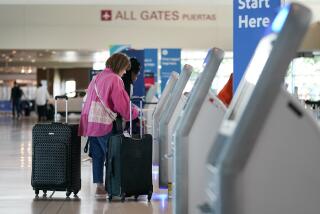FAA May Cut Proposal on Using Air Tracking Device
WASHINGTON — Hit by a huge backlash from the aviation industry, the Federal Aviation Administration appears ready to back away from a recent proposal that would have expanded dramatically the required use of altitude-tracking equipment by private pilots.
In recent meetings with angry industry officials, participants said this week, FAA Administrator T. Allan McArtor has indicated that he is willing to scale back--perhaps severely--a February proposal that would have mandated use of altitude-reporting Mode C transponders for all planes operating within 40 miles of 254 airports in the nation.
That proposed rule would have effectively prohibited planes without the special transponders from flying over most of Southern California.
In offering its original proposal three months ago, the FAA said it could significantly reduce the chance of aerial collisions. Impetus for the measure was provided in part by the August, 1986, collision over Cerritos of an airliner and a small private plane.
The transponders transmit an electronic signal to air traffic controllers’ radar equipment, giving a plane’s altitude. The signal also can trigger computer collision alert systems on some airliners.
However, the proposal has sparked a storm of protest, with the agency being deluged by 60,000 letters on the issue. Pilots and other critics charge that the dramatic increase in signals would overwhelm the air traffic control system, making it less responsive for all fliers.
They also maintain that the requirement for the device, which ranges in cost from $600 to $2,000 installed, also is an unjustified regulatory intrusion upon the activities of crop-dusters and other pilots who have no need to be in touch with airports. Some antique and experimental planes and gliders without electrical systems would effectively be grounded.
“There’s not much doubt (the FAA proposal) will undergo a lot of changes before it’s done,” Dan Todd, senior vice president of the Aircraft Owners and Pilots Assn., said in an interview. The FAA is to announce its final version of the rule by the end of June.
Narrowed Requirement
Several aviation industry officials who have taken part in recent discussions with the FAA said they believe the proposed requirement will be narrowed to encompass planes flying within about 20 miles of some airports, rather than 40 miles.
The number of airports affected could also drop by about 100 from the 254 now proposed, industry officials said. Currently, the transponders are required of all planes flying in the restricted airspace surrounding the nation’s 23 busiest airports, including Los Angeles International and Lindbergh Field in San Diego.
The proposed altitude requirements also could be relaxed. Under the proposal, all planes flying higher than 6,000 feet would have to have the equipment, compared to 12,500 feet now.
At an industry conference in Atlanta earlier this month, at which McArtor appeared, FAA officials “were looking to us for ways to help them justify scaling the proposal back,” Paul Poberezny, president of the 120,000-member Experimental Aircraft Assn., said in an interview.
In testimony at congressional hearings in recent months, McArtor has indicated that the requirements will be modified, but he said it was too early to provide details. One FAA official who asked not to be identified acknowledged that a number of plans are being considered.
An FAA spokesman said the agency customarily proposes far-reaching regulatory rules to elicit comment in determining a regulation’s proper bounds.
Underestimated Response
Nonetheless, Todd of the aircraft owners’ association said, FAA officials “severely underestimated the nature and degree to which the aviation community would respond to this proposal. They didn’t realize the fire this would start, and now they’re pulling back.”
The controversy comes as the FAA is under attack from inside the Administration and from Congress over its slow-moving bureaucratic process for enacting safety regulations.
Recently, Congress passed legislation mandating tighter requirements for transponders to bolster safety. However, in a letter last month to Transportation Secretary James H. Burnley IV, 18 senators said that “this (FAA) rule is unreasonable and goes far beyond the intent of Congress.”
For air traffic controllers trying to keep track of the additional planes using transponders, “the additional data and clutter would make an already difficult job that much more difficult. Indeed, it could undermine safety, given the shortage of experienced controllers,” the letter said.
More to Read
Inside the business of entertainment
The Wide Shot brings you news, analysis and insights on everything from streaming wars to production — and what it all means for the future.
You may occasionally receive promotional content from the Los Angeles Times.










